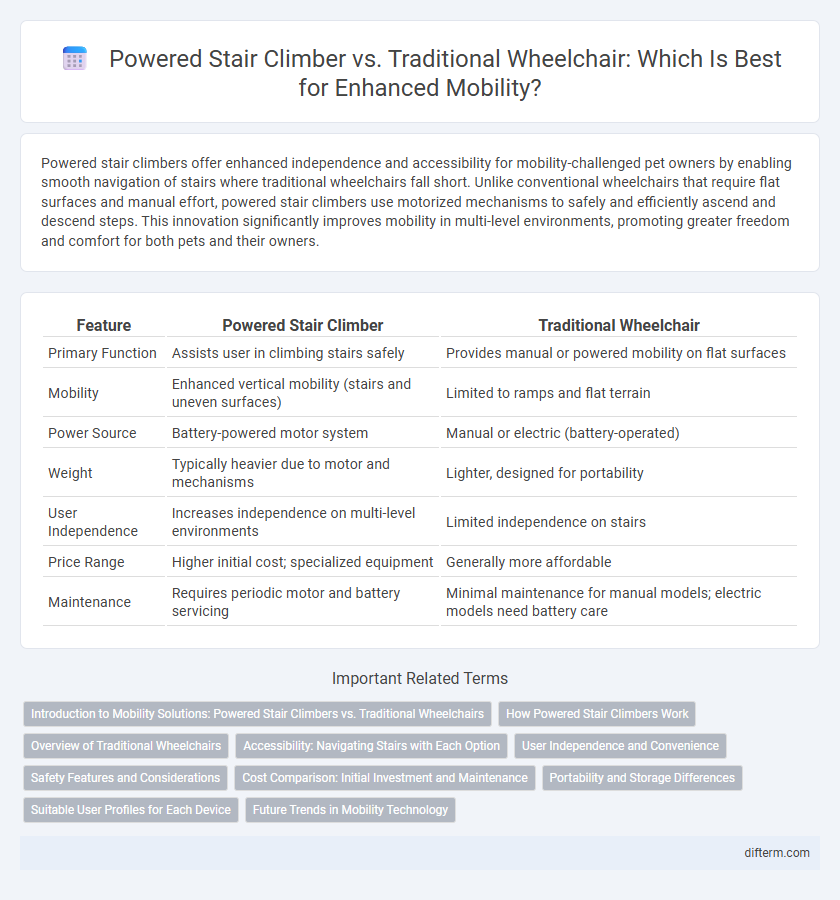Powered stair climbers offer enhanced independence and accessibility for mobility-challenged pet owners by enabling smooth navigation of stairs where traditional wheelchairs fall short. Unlike conventional wheelchairs that require flat surfaces and manual effort, powered stair climbers use motorized mechanisms to safely and efficiently ascend and descend steps. This innovation significantly improves mobility in multi-level environments, promoting greater freedom and comfort for both pets and their owners.
Table of Comparison
| Feature | Powered Stair Climber | Traditional Wheelchair |
|---|---|---|
| Primary Function | Assists user in climbing stairs safely | Provides manual or powered mobility on flat surfaces |
| Mobility | Enhanced vertical mobility (stairs and uneven surfaces) | Limited to ramps and flat terrain |
| Power Source | Battery-powered motor system | Manual or electric (battery-operated) |
| Weight | Typically heavier due to motor and mechanisms | Lighter, designed for portability |
| User Independence | Increases independence on multi-level environments | Limited independence on stairs |
| Price Range | Higher initial cost; specialized equipment | Generally more affordable |
| Maintenance | Requires periodic motor and battery servicing | Minimal maintenance for manual models; electric models need battery care |
Introduction to Mobility Solutions: Powered Stair Climbers vs. Traditional Wheelchairs
Powered stair climbers enhance mobility by enabling users to navigate stairs independently, overcoming architectural barriers that traditional wheelchairs cannot surmount. These devices combine motorized assistance with secure traction systems, offering increased safety and efficiency in multi-level environments. Traditional wheelchairs provide essential flat-surface mobility but often require external assistance or ramps to ascend staircases, limiting accessibility in complex settings.
How Powered Stair Climbers Work
Powered stair climbers use motorized tracks or wheels to safely lift and lower individuals while navigating stairs, providing enhanced mobility compared to traditional wheelchairs. Advanced sensors and stabilizing mechanisms ensure balanced movement and prevent tipping during ascent or descent. Their ergonomic design reduces physical strain for users and caregivers, making stair navigation more accessible and efficient.
Overview of Traditional Wheelchairs
Traditional wheelchairs offer manual propulsion with large rear wheels and smaller front casters, providing mobility primarily on flat, even surfaces. Designed for ease of use and portability, these wheelchairs require upper body strength for self-propulsion and may pose challenges on stairs or uneven terrain. While cost-effective and widely available, traditional wheelchairs lack the powered assistance needed for stair climbing or navigating complex environments.
Accessibility: Navigating Stairs with Each Option
Powered stair climbers enable users to ascend and descend stairs independently, significantly enhancing accessibility compared to traditional wheelchairs, which typically require ramps or elevators. These devices are equipped with advanced traction systems and safety features that facilitate smooth navigation on various stair types, reducing the risk of accidents. Traditional wheelchairs rely on external assistance or infrastructure modifications, limiting mobility in environments without wheelchair-friendly stairs or elevators.
User Independence and Convenience
Powered stair climbers significantly enhance user independence by enabling effortless navigation of stairs without assistance, unlike traditional wheelchairs that require ramps or lifts. These advanced devices incorporate ergonomic controls and automated mechanisms, providing greater convenience for users in diverse environments. As a result, powered stair climbers reduce reliance on caregivers and expand accessibility, fostering autonomy in daily mobility tasks.
Safety Features and Considerations
Powered stair climbers incorporate advanced safety features such as automatic braking systems, anti-tip technology, and secure harnesses that significantly reduce the risk of falls and accidents compared to traditional wheelchairs. Traditional wheelchairs lack integrated mechanisms to safely navigate stairs, increasing the likelihood of instability and injury during stair use. Users of powered stair climbers benefit from enhanced control and stability, particularly on uneven or inclined surfaces, ensuring safer mobility in multi-level environments.
Cost Comparison: Initial Investment and Maintenance
Powered stair climbers generally require a higher initial investment than traditional wheelchairs, with prices ranging from $5,000 to $15,000 compared to $300 to $1,500 for standard models. Maintenance costs for powered stair climbers tend to be more expensive due to complex electronic components and battery replacements, often averaging $200 to $500 annually. In contrast, traditional wheelchairs have lower ongoing costs, primarily involving tire and brake upkeep, typically below $100 per year.
Portability and Storage Differences
Powered stair climbers feature compact, foldable designs that enhance portability and ease of storage in small spaces, unlike traditional wheelchairs which often have bulkier frames requiring more room for transport and storage. The lightweight materials and modular components of powered stair climbers enable convenient handling in vehicles and tight environments. Traditional wheelchairs, while offering stability, typically demand larger storage areas due to fixed frames and lack of integrated folding mechanisms.
Suitable User Profiles for Each Device
Powered stair climbers are ideal for users with limited upper body strength and those living in multi-story environments where navigating stairs independently is essential. Traditional wheelchairs suit users with sufficient upper body mobility who primarily navigate flat, accessible surfaces indoors or outdoors. Choosing between these devices depends on the user's physical capabilities and the architectural barriers in their daily environment.
Future Trends in Mobility Technology
Powered stair climbers offer significant advancements over traditional wheelchairs by incorporating smart sensors and AI-driven navigation systems that enhance user independence in multi-level environments. Future trends in mobility technology emphasize integration with IoT devices, enabling real-time terrain adaptation and seamless control via smartphones or voice commands. Innovations in lightweight, durable materials and battery efficiency continue to improve the portability and operational time of powered stair climbers, setting new standards for accessible mobility solutions.
powered stair climber vs traditional wheelchair Infographic

 difterm.com
difterm.com